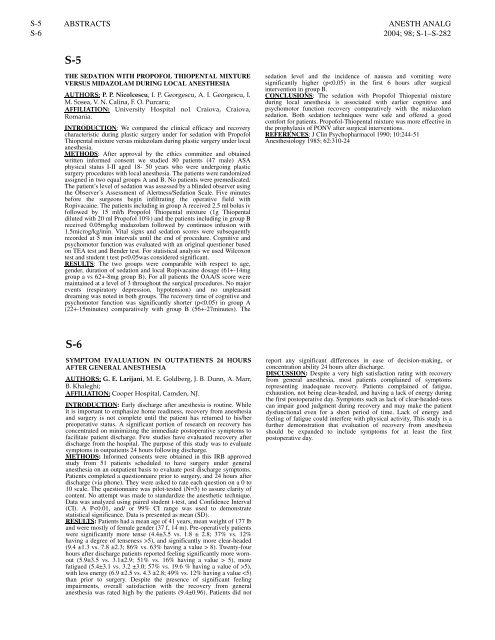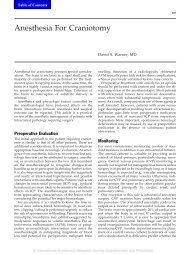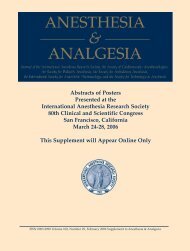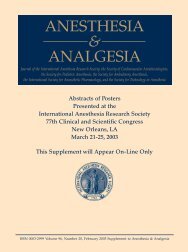ANESTHESIA & ANALGESIA - IARS
ANESTHESIA & ANALGESIA - IARS
ANESTHESIA & ANALGESIA - IARS
Create successful ePaper yourself
Turn your PDF publications into a flip-book with our unique Google optimized e-Paper software.
S-5<br />
S-6<br />
ABSTRACTS ANESTH ANALG<br />
2004; 98; S-1–S-282<br />
S-5<br />
THE SEDATION WITH PROPOFOL THIOPENTAL MIXTURE<br />
VERSUS MIDAZOLAM DURING LOCAL <strong>ANESTHESIA</strong><br />
AUTHORS: P. P. Nicolcescu, I. P. Georgescu, A. I. Georgescu, I.<br />
M. Sosea, V. N. Calina, F. O. Purcaru;<br />
AFFILIATION: University Hospital no1 Craiova, Craiova,<br />
Romania.<br />
INTRODUCTION: We compared the clinical efficacy and recovery<br />
characteristic during plastic surgery under for sedation with Propofol<br />
Thiopental mixture versus midazolam during plastic surgery under local<br />
anesthesia.<br />
METHODS: After approval by the ethics committee and obtained<br />
written informed consent we studied 80 patients (47 male) ASA<br />
physical status I-II aged 18- 50 years who were undergoing plastic<br />
surgery procedures with local anesthesia. The patients were randomized<br />
assigned in two equal groups A and B. No patients were premedicated.<br />
The patient’s level of sedation was assessed by a blinded observer using<br />
the Observer’s Assessment of Alertness/Sedation Scale. Five minutes<br />
before the surgeons begin infiltrating the operative field with<br />
Ropivacaine. The patients including in group A received 2.5 ml bolus iv<br />
followed by 15 ml/h Propofol Thiopental mixture (1g Thiopental<br />
diluted with 20 ml Propofol 10%) and the patients including in group B<br />
received 0.05mg/kg midazolam followed by continuos infusion with<br />
1.5microg/kg/min. Vital signs and sedation scores were subsequently<br />
recorded at 5 min intervals until the end of procedure. Cognitive and<br />
psychomotor function was evaluated with an original questioner based<br />
on TEA test and Bender test. For statistical analysis we used Wilcoxon<br />
test and student t test p 5), more<br />
fatigued (5.4±3.1 vs. 3.2 ±3.0; 57% vs. 19.6 % having a value of >5),<br />
with less energy (6.9 ±2.5 vs. 4.3 ±2.8; 49% vs. 12% having a value





